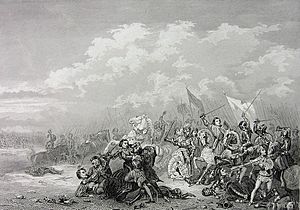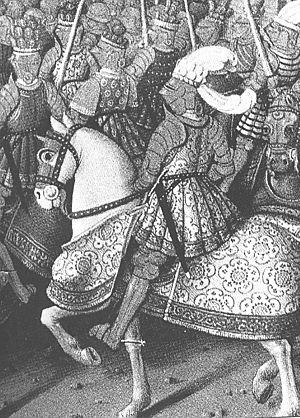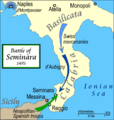Battle of Seminara facts for kids
Quick facts for kids Battle of Seminara |
|||||||
|---|---|---|---|---|---|---|---|
| Part of the First Italian War | |||||||
 Ferdinand II of Naples in peril at the height of the battle, only to be saved by a nobleman. Illustration by an unknown 19th century artist. |
|||||||
|
|||||||
| Belligerents | |||||||
| Commanders and leaders | |||||||
|
|
|||||||
The Battle of Seminara was a major fight during the First Italian War. It happened on June 28, 1495, in Calabria, which is in Southern Italy. This battle was between French soldiers, who had recently taken over the area, and a team of soldiers from Spain and Naples. The Spanish and Neapolitan forces were trying to win back their lands.
The French army had strong fighters called gendarmes (heavy cavalry) and skilled Swiss pikemen. These pikemen used very long spears. The Spanish and Neapolitan forces were not as strong. They had Neapolitan troops who weren't very experienced and a small group of Spanish soldiers. These Spanish soldiers were used to fighting lightly armed enemies like the Moors in Spain, not heavily armored knights and pikemen.
The battle ended in a big win for the French. The Spanish and Neapolitan forces had to run away. This battle is important because it made Spain change how its army was organized. They started using more firearms and new fighting styles, which was a big step in military history.
Contents
Why the Battle Happened
The French Invasion of Italy
In 1494, King Charles VIII of France decided to invade Italy. He wanted to claim the throne of the Kingdom of Naples. He believed he had a right to it because of his family, the House of Valois-Anjou. The king of Naples at the time was Ferdinand I of Naples. When he died, his son Alfonso II of Naples took over.
Alfonso II was scared of the French army coming. So, he gave up his throne to his son, Ferdinand II of Naples. But it was too late. The French army quickly moved through Italy. On February 21, 1495, they reached the Kingdom of Naples. King Ferdinand II of Naples had to escape to Sicily.
Ferdinand II Gets Help
While in Sicily, Ferdinand II met his cousin, Ferdinand II of Aragon. He was the King of Sicily and Spain. King Ferdinand of Spain offered to help his cousin get Naples back.
Many Italian states were worried about France's power in Italy. So, they formed a group called the League of Venice. This League gathered a strong army in northern Italy. Their goal was to stop the French army from getting supplies and help from France.
King Charles VIII realized he was in danger. On May 30, 1495, he split his army. He took about half of his soldiers (around 9,000 men) and marched north. He fought his way back to France. The rest of his army stayed behind to hold the lands they had taken in Naples. Charles's army fought a tough battle at Fornovo in July 1495 and made it back to France.
The Fight for Naples
Ferdinand's Plan to Take Back Naples
After King Charles VIII left, Ferdinand II of Naples was determined to get his kingdom back. The French soldiers were spread out in different parts of Naples. They had three main groups:
- The main group was in Naples, led by Gilbert d'Montpensier. He was brave but not very experienced.
- A group in the south, in Calabria, led by Bernard d'Aubigny. He was a skilled Scottish captain.
- Swiss mercenaries and other soldiers were in Basilicata, led by a French nobleman named Précy.
Ferdinand II had his own army, and help from Spain. The Spanish general Gonzalo Fernández de Córdoba was sent from Spain with a small army. More Spanish troops were coming later. Queen Isabella of Spain chose Fernández De Córdoba because he was a favorite at court and a well-known soldier, even though he was young.
Spanish and Neapolitan Forces Arrive
Fernández De Córdoba arrived in Messina on May 24, 1495. He found that Ferdinand II of Naples had already crossed into Calabria. Ferdinand had taken back Reggio with his fleet.
Fernández De Córdoba crossed to Calabria two days later. He had 600 Spanish cavalry, including light horsemen called jinetes. He also had 1,500 infantry, many of them rodeleros (soldiers with swords and shields). Another 3,500 soldiers from the Spanish fleet joined them. The size of the Neapolitan army is not clear, but 6,000 volunteers from Calabria joined Ferdinand II. Fernández De Córdoba's Spanish group became smaller because he had to leave soldiers in several forts that Ferdinand II gave to Spain for their help.
The combined army marched from Reggio to Sant'Agata del Bianco, then to Seminara. Seminara was a strong town about 28 miles (40 kilometers) from Reggio. Both towns welcomed Ferdinand II. On the way, they found and defeated a group of French soldiers. The League of Venice also helped by sending a Venetian fleet to attack French-held areas along the eastern coast of Naples.
French Commander Prepares for Battle
The French commander in Calabria, d’Aubigny, was very sick with malaria. But he quickly gathered his forces. He called in soldiers from other parts of Calabria and asked Précy to bring the Swiss mercenaries to help him. D’Aubigny soon had his army together and marched straight towards Seminara.
The Battle of Seminara
When Ferdinand II heard that d’Aubigny was coming, he decided to fight right away. He didn't know that Précy and the Swiss mercenaries had joined d’Aubigny. The Spanish and Neapolitan nobles agreed with Ferdinand. Fernández De Córdoba suggested being careful and checking the French army first, but he was overruled.
On June 28, Ferdinand led his army out of Seminara. They crossed some hills about 3 miles east of the town. Below them, on a plain, they saw the French army marching towards them. The French army was just beyond a stream at the bottom of the hills.
Armies Take Their Positions
Ferdinand placed his army behind the stream. His foot soldiers were on the left, and his cavalry (horse soldiers) were on the right. D’Aubigny, though sick, was on his horse leading the French. He put his cavalry on the French left, facing the allied cavalry. This group had 400 heavily armored gendarmes and 800 lighter horsemen. Précy, the young nobleman, gave up command of the Swiss mercenaries to help d'Aubigny with the cavalry.
To the right of the French cavalry were 800 Swiss pikemen. Behind them were the French foot soldiers. The Swiss usually fought in very deep groups, but at Seminara, they were in only three lines. Their 18-foot long pikes pointed forward, ready for battle. The French army attacked without waiting, moving into the stream.
The Fight Begins
At first, the battle went well for the Spanish and Neapolitans. The jinetes (light cavalry) bothered the French gendarmes as they crossed the stream. The jinetes would throw spears and then quickly ride away, just like they did against the Moors in Spain.
However, the Calabrian militia (local volunteers) suddenly panicked. They might have thought the jinetes were running away, or they might have been scared of the Swiss pikemen. They ran back, leaving the left side of the allied army open. Ferdinand tried to stop them, but the French gendarmes, who had now crossed the stream, attacked and rode down the fleeing Calabrians.
Allied Forces Retreat
The situation quickly became very bad for the Spanish and Neapolitans. The Swiss pikemen pushed through the remaining Spanish rodeleros. The French gendarmes defeated the allied cavalry. Ferdinand, who was easy to spot in his fancy clothes, was attacked heavily. He was knocked off his horse and was in danger. But a nobleman, either Giovanni di Capua or Juan de Altavista, gave Ferdinand his own horse. This nobleman then fought the enemy to give Ferdinand time to escape, and he died doing so.
Fernández De Córdoba led the Spanish cavalry and the remaining foot soldiers in a desperate fight to slow down the French. This, along with the French leader d’Aubigny being sick, allowed the Neapolitans to escape. Fernández De Córdoba himself fled back to Messina by boat that same day. He then went to Calabria to get new pikes for his soldiers and build a strong cavalry force.
What Happened After the Battle
French Garrison Weakens
Even though the French won a big battle, their situation in southern Italy was still difficult. They were far from home and surrounded by enemies. Soon after, Ferdinand II of Naples used a clever trick and a small force to take back Naples itself.
Meanwhile, Fernández De Córdoba used guerrilla tactics. This means he avoided big battles with the strong Swiss or French cavalry. Instead, he slowly took back the rest of Calabria by using small, surprise attacks.
Eventually, many of the French mercenaries (soldiers who fight for money) left because they weren't getting paid. The remaining French forces were trapped at Atella by the combined armies of Ferdinand and Fernández De Córdoba. They were forced to give up.
Changes to the Spanish Army
The terrible defeat at Seminara taught Fernández De Córdoba an important lesson. He realized his army needed to change to fight the strong French and Swiss forces. This led him to create a new type of army that combined pike and shot (soldiers with long pikes and soldiers with early firearms). These new units were called tercios.
After this humiliating loss at Seminara, Fernández De Córdoba never lost another battle. He earned the nickname El Gran Capitán ("the Great Captain"). Many historians today consider him one of the greatest military leaders of the Italian Wars.
Images for kids
-
Ferdinand II of Naples in peril at the height of the battle, only to be saved by a nobleman. Illustration by an unknown 19th century artist.
See also
 In Spanish: Batalla de Seminara (1495) para niños
In Spanish: Batalla de Seminara (1495) para niños






